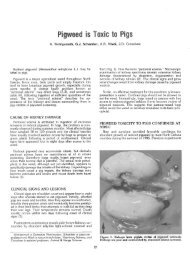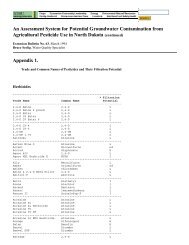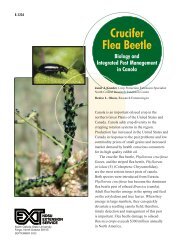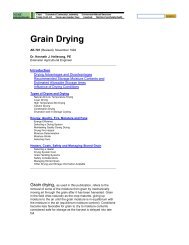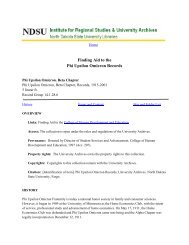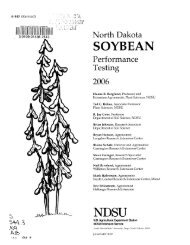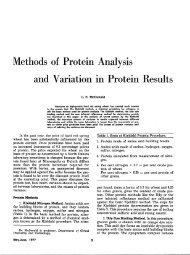germans from russia in fort collins, 1900-2000 - Libraries
germans from russia in fort collins, 1900-2000 - Libraries
germans from russia in fort collins, 1900-2000 - Libraries
Create successful ePaper yourself
Turn your PDF publications into a flip-book with our unique Google optimized e-Paper software.
WORK RENDERS LIFE SWEET: GERMANS FROM RUSSIA IN FORT COLLINS<br />
their true heritage the subject of suspicion<br />
and hatred.<br />
The Armistice failed to ease tensions<br />
between the Volga German community and<br />
the Englische. The Bolshevik Revolution of<br />
November 1917 and the violent “Red<br />
Summer” that followed sparked a new era of<br />
American xenophobia; anyone with connections<br />
to Russia was a “red” and a seditious<br />
anarchist. Aga<strong>in</strong>, the confusion of ethnicity<br />
and orig<strong>in</strong> acted as a conductor for popular<br />
hatred. Yet, perhaps as a result of the close<br />
bond Germans <strong>from</strong> Russia forged with other<br />
residents dur<strong>in</strong>g the 1904 flood, Fort Coll<strong>in</strong>s<br />
never experienced the level of violence that<br />
occurred <strong>in</strong> Denver and other northern<br />
Colorado communities. 86 While the rabidly<br />
anti-foreign Ku Klux Klan thrived <strong>in</strong> Denver<br />
dur<strong>in</strong>g the late teens and throughout the<br />
1920s, Fort Coll<strong>in</strong>s held the organization at<br />
bay. “The Ku Kluxers have had a man here<br />
the past few days try<strong>in</strong>g to organize Fort<br />
Coll<strong>in</strong>s,” writes the editor of the Express<br />
Courier <strong>in</strong> 1924. “This old town is do<strong>in</strong>g<br />
pretty well and feels no need of the strife, dissension<br />
and turmoil that usually follow when<br />
the Klan gets a good hold.” 87<br />
National economic downturns threatened<br />
Fort Coll<strong>in</strong>s’s German-Russian community as<br />
well. Many German-Russians spoke of two<br />
depressions – the first followed World War I<br />
and the second was the Great Depression.<br />
The end of the economic panics <strong>in</strong> the 1890’s<br />
through World War I was a rare golden age<br />
for the American farmer. Farm prices rose<br />
faster than other prices for two reasons. First,<br />
the <strong>in</strong>ternational agricultural market was<br />
much stronger dur<strong>in</strong>g this period than it had<br />
been <strong>in</strong> the 1880’s and 1890’s. Second, settlers<br />
established few new farms after <strong>1900</strong>;<br />
most of the suitable farmland <strong>in</strong> the country<br />
had already been settled. The demand for<br />
farm commodities balanced, at least briefly,<br />
with the supply. 88 But while other sectors of<br />
the economy boomed dur<strong>in</strong>g the “roar<strong>in</strong>g<br />
twenties,” agriculture first revealed the catastrophic<br />
cracks <strong>in</strong> the American economy.<br />
European recovery after World War I reduced<br />
the demand for American gra<strong>in</strong>s while<br />
domestic farm production rema<strong>in</strong>ed high.<br />
Crop prices lagged beh<strong>in</strong>d those farmers paid<br />
for manufactured goods. In turn, those goods<br />
<strong>in</strong>cluded new farm equipment, which<br />
<strong>in</strong>creased the amount of acres available for<br />
commercial production dur<strong>in</strong>g a time when<br />
demand was fall<strong>in</strong>g. “Devot<strong>in</strong>g [mach<strong>in</strong>ery]<br />
to the production of cash crops did not benefit<br />
farmers as a group,” writes historian<br />
Stephan Thernstrom. “The result<strong>in</strong>g <strong>in</strong>crease<br />
<strong>in</strong> supply relative to demand simply drove<br />
prices down.” 89 This slump <strong>in</strong> agricultural<br />
prices only worsened dur<strong>in</strong>g the Great<br />
Depression.<br />
But as a people conditioned to scrimp<strong>in</strong>g<br />
and sav<strong>in</strong>g, the German Russia community<br />
survived and may have even prospered dur<strong>in</strong>g<br />
the depressions. Certa<strong>in</strong>ly, many German-<br />
Russians, like all Americans, lost their farms<br />
or jobs on the farm. But the relative prosperity<br />
of the sugar beet <strong>in</strong>dustry may have<br />
allowed farmers and laborers to survive the<br />
economic downturn. The average value of the<br />
sugar beet crop <strong>in</strong> Colorado dur<strong>in</strong>g the Great<br />
Depression was $25,820,000 a year. While<br />
Colorado farmers grew beets on only ten percent<br />
of all irrigated land <strong>in</strong> the sixteen lead<strong>in</strong>g<br />
beet-grow<strong>in</strong>g counties <strong>from</strong> 1929 to 1939, the<br />
average value of the crop totaled 40 percent<br />
of the value of all pr<strong>in</strong>cipal crops grown on<br />
irrigated land <strong>in</strong> the state. Moreover, the federal<br />
Sugar Act of 1937 reduced tariffs and<br />
substituted a more comprehensive, albeit<br />
<strong>in</strong>direct, means of regulat<strong>in</strong>g sugar prices,<br />
beet prices, grower-processor relationships,<br />
and wages. This redistributed beet profits <strong>in</strong><br />
favor of farmers and field workers at the<br />
SWCA Environmental Consultants Page 25



